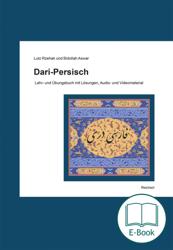This textbook offers a communicative-oriented introduction to the Dari-Persian language of Afghanistan and aims to acquire a comprehensive basic knowledge.
An introductory chapter is devoted to the Arabic-Persian script and the pronunciation of Dari-Persian. In forty further chapters, the learners are enabled to exchange ideas in representative communicative situations, initially on concrete, real-life topics and later on more abstract content. Numerous aspects of regional culture and history are also examined here. Vocabulary and grammar are taught step by step according to the communicative requirements. Important phrases that enable lively communication are provided as a means of expression. The solution part enables self-control of the exercises. Two glossaries summarize the vocabulary taught. Audio recordings are also available for many texts, dialogues and vocabulary lists. Video materials support learning to write and later help to acquire new words in sound and writing. The Dari-Persian textbook ranges from level A1 to B1 of the European Framework of Reference and is suitable for both teaching and self-study.
This textbook has been designed to provide a practical introduction to the Dari-Persian language of Afghanistan. The textbook is communicatively oriented and aims to impart basic knowledge that can be expanded. The Arabic-Persian script is taught in a preparatory chapter and is supported by audio and video files. In the following forty chapters, learners are enabled to exchange information on concrete, real-life topics and later on more abstract facts in representative communicative situations. Numerous aspects of local culture from the areas of etiquette and communication culture, history, customs, calendar systems, religion, media, etc. are also covered.
Vocabulary and grammar are taught step by step according to the communicative requirements. Important phrases are given as means of expression, with the help of which lively communication is to be achieved. Individual phrases or grammatical phenomena are illustrated at their introduction by means of typical short dialogues or other examples of use. They are intended to show how a particular aim of communication can be implemented using the new phrase or grammatical construction. The final chapter offers an introduction to the colloquial Dari Persian of Afghanistan, which has some differences compared to the written language standard, which is conveyed in this textbook.
At the end of each chapter, learners will find a list of the vocabulary taught in this chapter in Persian script and in phonetic transcription with German equivalents. For learning or repeating new words, For learning or repeating new words, the Media Library also offers audio files and video files to help memorize new words in sound and writing.
Numerous exercises are provided to teach and reinforce the material and to develop practical language skills. For many exercises, there are solutions for self-monitoring by the learners, which are provided in a separate section. Such solutions are usually provided for translation exercises at the end of a chapter, but also for some other tasks.
The textbook ranges from level A1 to B1 of the European Framework of Reference for Foreign Language Proficiency and is suitable for teaching with a teacher as well as for and self-study.
Bidollah Aswar
1969 born in Zabol, Afghanistan
Study of foreign languages (1987-1988 in Kabul, 1988-1989 in Prague, 1991-1996 in Minsk), bachelor of arts
Current employment: staff-member at the Central-Asian Seminar at Humboldt-Universität zu Berlin
Lutz Rzehak
1962 born in Reichenbach, Germany
1080-1985: Study at the Faculty of Oriental Studies of St. Petersburgh State University. Diploma in oriental studies
1991: PhD in Iranian studies at Humboldt-Universität zu Berlin
2001: Habilitation and license to teach in Iranian/Central-Asien studies at Humboldt-Universität zu Berlin
Current employment: Associate professor (Privatdozent) and lecturer of Dari and Pashto at the Central-Asian Seminar at Humboldt-Universität zu Berlin


 Table of Contents
Table of Contents